>>>Natures Of Universe<<<
Home Page › Forums › API Clubhouse › Interesting Shows/Websites/Book Previews › >>>Natures Of Universe<<<
- This topic is empty.
-
AuthorPosts
-
November 1, 2005 at 9:43 am #5183
Anonymous
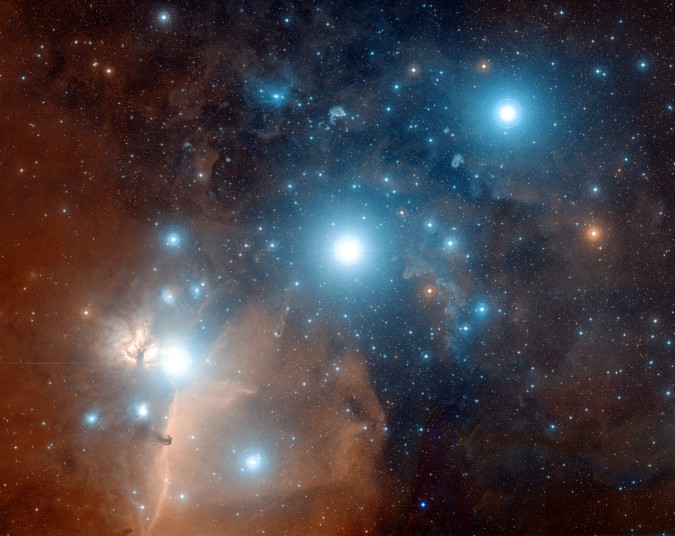
Alnitak, Alnilam, Mintaka
Explanation: Alnitak, Alnilam, and Mintaka, are the bright bluish stars from east to west (left to right) along the diagonal in this gorgeous cosmic vista. Otherwise known as the Belt of Orion, these three blue supergiant stars are hotter and much more massive than the Sun. They lie about 1,500 light-years away, born of Orion’s well-studied interstellar clouds. In fact, clouds of gas and dust adrift in this region have intriguing and some surprisingly familiar shapes, including the dark Horsehead Nebula and Flame Nebula near Alnitak at the lower left. The famous Orion Nebula itself lies off the bottom of this star field that covers an impressive 4.4×3.5 degrees on the sky. The color picture was composited from digitized black and white photographic plates recorded through red and blue astronomical filters, with a computer synthesized green channel. The plates were taken using the Samuel Oschin Telescope, a wide-field survey instrument at Palomar Observatory, between 1987 and 1991.
Credit: Digitized Sky Survey, ESA/ESO/NASA FITS Liberator
Color Composite: Davide De Martin (Skyfactory)November 1, 2005 at 9:45 am #5184Anonymous

Dusty Environs of Eta Carinae
Explanation: Eta Car is a massive star, but it’s not as bright as it used to be. Now only easily visible in binoculars or a small telescope, Eta Carinae has a history of spectacular flaring and fading behavior. In fact, in April of 1843 Eta Car briefly became second only to Sirius as the brightest star in planet Earth’s night sky, even though at a distance of about 7,500 light-years, it is about 800 times farther away. Surrounded by a complex and evolving nebula, Eta Carinae is seen near the center of this false-color infrared image, constructed using data from the Midcourse Space Experiment (MSX). The MSX satellite mapped the galactic plane in 1996. In the picture, wispy, convoluted filaments are clouds of dust glowing at infrared wavelengths. Astronomers hypothesize that Eta Car itself will explode as a supernova in the next million years or so. Massive Eta Car has even been considered a candidate for a hypernova explosion and the potential source of a future gamma-ray burst.
Credit: MSX, IPAC, NASA
November 1, 2005 at 9:46 am #5185Anonymous
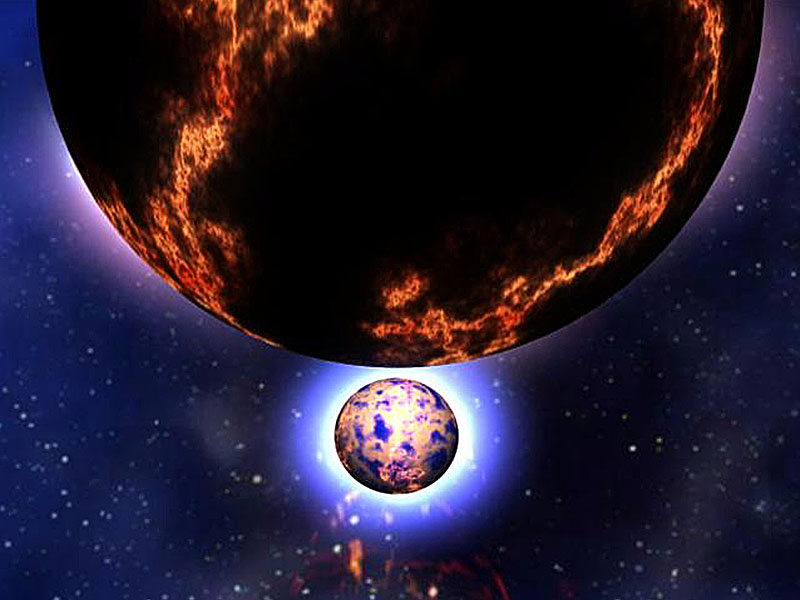
Short Gamma-Ray Bursts Localized
Explanation: What causes gamma-ray bursts? The most energetic type of explosions known in the cosmos has been an enigma since discovered over 30 years ago. It now appears that there may not be one unique type of progenitor. Long duration gamma-ray bursts (GRBs) have been localized, over the past few years, to blue regions in the universe rich in star formation. Massive young stars nearing the end of their short lives commonly explode in these regions. Astronomers associate these long duration GRBs, that can last from seconds to minutes, with a type of stellar explosion common in young massive stars. Over the past few months, short duration GRBs have finally been localized and found to occur in different types of regions — not only blue regions rich in star formation. Many astronomers therefore now theorize that short GRBs, which typically last less than one second, are the result of a different progenitor process than long GRBs. A leading model is that a short GRB will occur when a neutron star either impacts another neutron star or a black hole. Such collisions may occur well after star-forming regions have otherwise burned out. Pictured in the above illustration, two energized neutrons stars finally approach each other in their orbits, a death spiral that might end with a short GRB.
Illustration Credit: Dana Berry, NASA
November 1, 2005 at 9:47 am #5186Anonymous
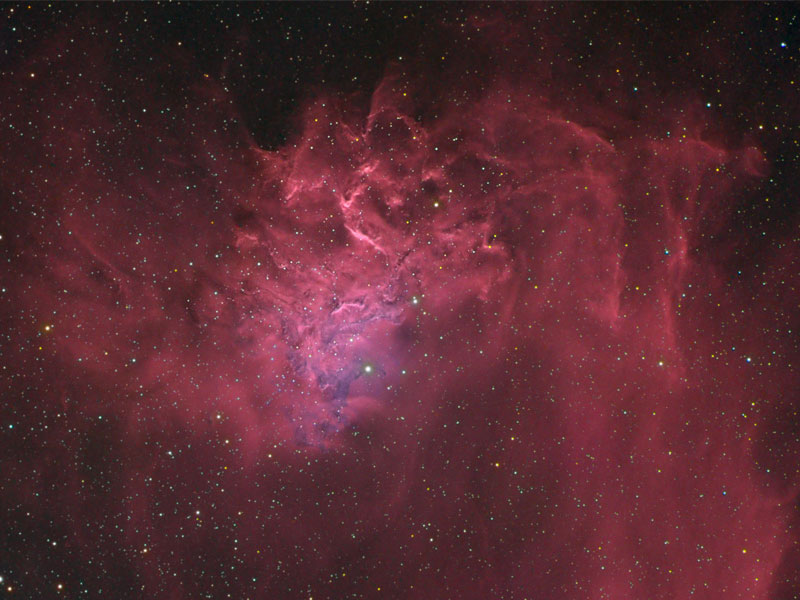
AE Aurigae: The Flaming Star
Explanation: Is star AE Aurigae on fire? No. Even though AE Aurigae is named the flaming star, the surrounding nebula IC 405 is named the Flaming Star Nebula, and the region appears to harbor red smoke, there is no fire. Fire, typically defined as the rapid molecular acquisition of oxygen, happens only when sufficient oxygen is present and is not important in such high-energy, low-oxygen environments such as stars. The material that appears as smoke is mostly interstellar hydrogen, but does contain smoke-like dark filaments of carbon-rich dust grains. The bright star AE Aurigae, visible just below the image center, is so hot it is blue, emitting light so energetic it knocks electrons away from surrounding gas. When a proton recaptures an electron, red light is frequently emitted, as seen in the surrounding emission nebula. Pictured above, the Flaming Star nebula lies about 1,500 light years distant, spans about 5 light years, and is visible with a small telescope toward the constellation of the Charioteer (Auriga).
Credit & Copyright: Thomas V. Davis (tvdavisastropix.com)
[/b]November 1, 2005 at 10:07 am #5187Anonymous
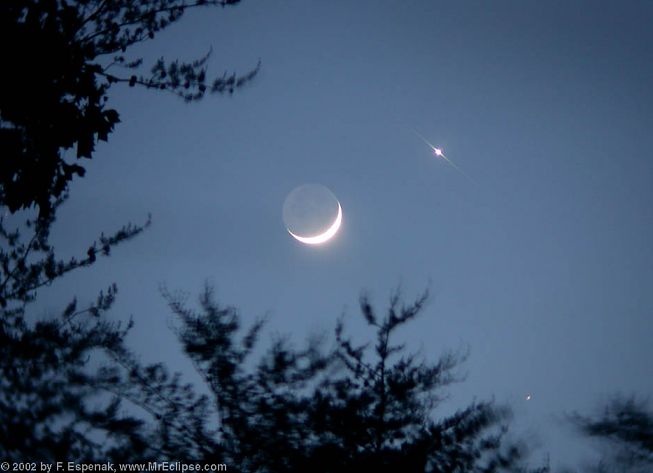
On the Possibility of Ascending to Mars
Explanation: On another October 19, in 1899, a 17 year-old Robert Goddard climbed a cherry tree on a beautiful autumn afternoon in Worcester, Massachusetts. Inspired by H.G. Wells’ War of the Worlds and gazing out across a meadow, young Goddard imagined it would be wonderful to make a device that had the possibility of ascending to Mars. Forever more he felt his life had a purpose and in the following years his diary entries record October 19th as “Anniversary Day”, the anniversary of his ascent into the cherry tree. By 1926 he had designed, built, and flown the world’s first liquid fuel rocket. Mars is just visible through the trees at the lower right in this dramatic sky view that also features the Moon and Venus — all visited by liquid fuel rockets constructed on principles developed by Goddard.
Image Credit & Copyright: Fred Espenak ( http://www.MrEclipse.com)
November 1, 2005 at 10:09 am #5188Anonymous

Ring Galaxy AM 0644-741 from Hubble
Explanation: How could a galaxy become shaped like a ring? The rim of the blue galaxy pictured on the right is an immense ring-like structure 150,000 light years in diameter composed of newly formed, extremely bright, massive stars. That galaxy, AM 0644-741, is known as a ring galaxy and was caused by an immense galaxy collision. When galaxies collide, they pass through each other — their individual stars rarely come into contact. The ring-like shape is the result of the gravitational disruption caused by an entire small intruder galaxy passing through a large one. When this happens, interstellar gas and dust become condensed, causing a wave of star formation to move out from the impact point like a ripple across the surface of a pond. The intruder galaxy has since moved out of the frame taken by the Hubble Space Telescope and released to commemorate the anniversary of Hubble’s launch in 1990. Ring galaxy AM 0644-741 lies about 300 million light years away.
Credit : Hubble Heritage Team (AURA / STScI), J. Higdon (Cornell) ESA, NASA
[/b]November 1, 2005 at 10:10 am #5189Anonymous

Supernova Remnant N132D in Optical and X Rays
Explanation: Thousands of years after a star exploded, its expanding remnant still glows brightly across the spectrum. Such is the case with N132D, a supernova remnant located in the neighboring Large Magellanic Cloud (LMC) galaxy. The expanding shell from this explosion now spans 80 light-years and has swept up about 600 Suns worth of mass. N132D was imaged recently in optical light and in great detail with the Hubble Space Telescope. The Hubble image was then combined with a position coincident detailed image in X-ray light taken by the Chandra X-ray Observatory. The combination, shown above in representative colors, shows a nearly spherical expanding shockwave highlighted by pink emission from hydrogen gas and purple emission from oxygen gas. A dense field of unrelated stars also from the LMC populates the image. Studying the image gives an opportunity to study material once hidden deep inside a star. N132D spans about 150 light years and lies about 160,000 light years away toward the constellation of Dorado.
Credit : NASA, ESA, and The Hubble Heritage Team (STScI/AURA)
Acknowledgment: J.C. Green (Univ. of Colorado) and the Cosmic Origins Spectrograph (COS) GTO team; NASA/CXO/SAONovember 1, 2005 at 10:12 am #5190Anonymous

NGC 3242: The Ghost of Jupiter
Explanation: After a star like the Sun completes fusion in its core, it throws off its outer layers in a brief, beautiful cosmic display called a planetary nebula. NGC 3242 is such a planetary nebula, with the stellar remnant white dwarf star visible at the center. This nebula is sometimes called The Ghost of Jupiter for its faint, but similar appearance to our solar system’s ruling gas giant planet. NGC 3242 is light-years across however, and much farther away than the measly 40 light-minutes distance to Jupiter. In fact, while watching this ghostly nebula expand over time, astronomers have estimated the distance to NGC 3242 to be about 1,400 light-years. The red FLIERs visible near the edges of the nebula are still a bit mysterious, though.
Credit: Bruce Balick (U. Washington) et al., HST, NASA
November 1, 2005 at 10:13 am #5191Anonymous

A Martian Halloween
Explanation: From sunset to sunrise, an unusually bright yellowish orb will hang in the sky this Halloween: Mars. Yesterday, Earth passed Mars as they orbited the Sun, bringing Mars closer than it will be for the next thirteen years. Tonight though, Mars will be nearly as bright as last night, a beacon of extraterrestrial spookiness. Opposite the Sun, Mars will rise just when the Sun sets, set just when the Sun rises, and be visible the entire night. Mars will not always be the brightest object in tonight’s sky, though. The last quarter Moon will rise near midnight. Brighter than even Mars, almost spooky Venus will light up the western horizon for a brief time just after sunset. Please have a safe and happy All Hallows Eve.
Credit & Copyright: Wally Pacholka (Astropics.com)
November 1, 2005 at 10:14 am #5192Anonymous
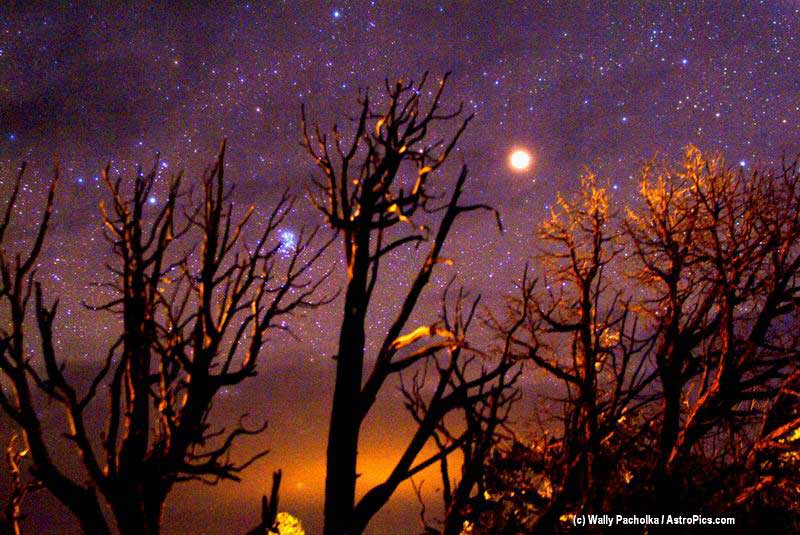
A Martian Halloween
Explanation: From sunset to sunrise, an unusually bright yellowish orb will hang in the sky this Halloween: Mars. Yesterday, Earth passed Mars as they orbited the Sun, bringing Mars closer than it will be for the next thirteen years. Tonight though, Mars will be nearly as bright as last night, a beacon of extraterrestrial spookiness. Opposite the Sun, Mars will rise just when the Sun sets, set just when the Sun rises, and be visible the entire night. Mars will not always be the brightest object in tonight’s sky, though. The last quarter Moon will rise near midnight. Brighter than even Mars, almost spooky Venus will light up the western horizon for a brief time just after sunset. Please have a safe and happy All Hallows Eve.
Credit & Copyright: Wally Pacholka (Astropics.com)
[/b]November 1, 2005 at 10:15 am #5193Anonymous

A Soyuz Spacecraft Approaches the Space Station
Explanation: Last month, a Soyuz TMA-7 spacecraft docked with the International Space Station. The spacecraft was launched a few days earlier from the Baikonur Cosmodrome in Kazakhstan. Pictured above, the approaching Soyuz spacecraft carried the new Expedition 12 crew to the Earth-orbiting International Space Station (ISS), as well as fee-paying spaceflight participant. The Expedition 12 crew is expected to stay on the ISS for about six months, while replacing the Expedition 11 crew who had been on the station for about six months themselves. About a week after this image was taken, the Expedition 11 crew returned to Earth in the Soyuz capsule, along with the spaceflight participant. The Expedition 12 crew will carry out repairs on the ISS, explore new methods of living in space, and conduct research in space including a kidney stone experiment.
Credit : ISS Expedition 11 Crew, NASA
November 2, 2005 at 7:58 am #5194Anonymous

Epimetheus and Janus: Interchangeable Moons of Saturn
Explanation: These two moons change places. Epimetheus and Janus, two small moons of Saturn, actually switch positions as they orbit their home planet. The orbital radii of the moons are strangely separated by less than the radii of the moons themselves: about 50 kilometers. One moon orbits Saturn well ahead of the other, at first. As the two moons gravitationally attract, they approach each other and, every few years, actually pass and trade orbits. This strange dance creates speculation that Epimetheus and Janus were once joined and later split from each other. Pictured above, the two moons were photographed rounding their orbits just outside of Saturn’s F ring. The above image was taken in early September by the robot Cassini spacecraft, also orbiting Saturn.
Credit : Cassini Imaging Team, SSI, JPL, ESA, NASA
November 3, 2005 at 1:49 pm #5195Anonymous
@abductboy wrote:
These are beautiful pictures….
Hi aductboy:
Posting these beautiful pictures was Water Rat’s idea
Be Blessed
😉
November 3, 2005 at 1:52 pm #5196Anonymous
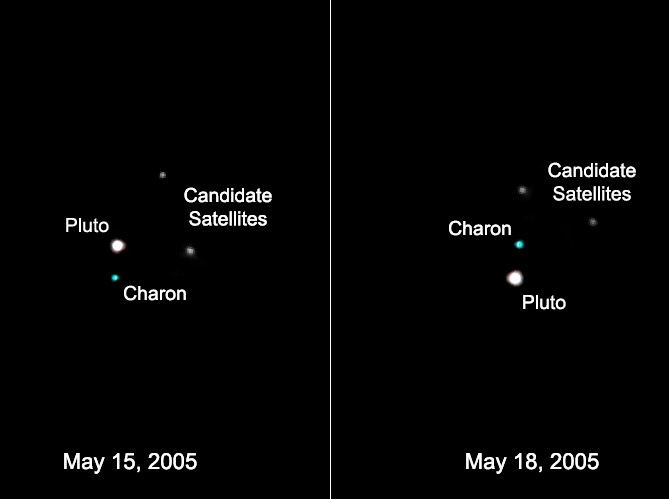
Possible Pluto Moons
Explanation: In 1930, tiny, icy world Pluto was discovered orbiting in the distant solar system. In 1978, its relatively large companion Charon was detected by ground-based observations. This year, the Hubble Space Telescope may well have detected two further members of the Pluto system. Provisionally designated S/2005 P1 and S/2005 P2, the two potential new moons are seen orbiting in a counterclockwise direction about 44,000 kilometers (27,000 miles) from Pluto in these deep Hubble images recorded only three days apart. The diminutive and faint companions are also apparently detected on Hubble images of Pluto from 2002, but this coming February follow-up observations are planned in an effort to confirm the discovery of the new moons. Compared to Pluto’s and Charon’s diameters of 2,300 and 1,300 kilometers respectively, these moons are estimated to be between 60 and 200 kilometers across. Well within the Kuiper Belt, an extensive region beyond the orbit of Neptune, the Pluto system could be the first quadruple Kuiper Belt object known.
Credit : H. Weaver (JHU / APL), A. Stern (SwRI), and the HST Pluto Companion Search Team, ESA, NASA
November 3, 2005 at 1:56 pm #5197Anonymous

Galactic Magnetar Throws Giant Flare
Explanation: Was the brightest Galactic blast yet recorded a key to connecting two types of celestial explosions? Last December, a dense sheet of gamma rays only a few times wider than the Earth plowed through our Solar System, saturating satellites and noticeably reflecting off the Moon. A magnetar near our Galactic Center, the source of Soft Gamma Repeater (SGR) 1806-20, had unleashed its largest flare on record. The brightness and briefness of the tremendous explosion’s initial peak made it look quite similar to another type of tremendous explosion if viewed from further away — a short duration gamma-ray burst (GRB). Short duration GRBs are thought by many to be fundamentally different than their long duration GRB cousins that are likely related to distant supernovas. Illustrated above is a series of drawings depicting an outgoing explosion during the initial SGR spike. A fast moving wave of radiation is pictured shooting away from a central magnetar. The possible link between SGRs and GRBs should become better understood as more and similar events are detected by the Earth-orbiting Swift satellite.
Illustration Credit & Copyright: Robert Mallozzi (UAH, MSFC)
-
AuthorPosts
-
AuthorPosts
-
Anonymous- Offline

Alnitak, Alnilam, Mintaka
Explanation: Alnitak, Alnilam, and Mintaka, are the bright bluish stars from east to west (left to right) along the diagonal in this gorgeous cosmic vista. Otherwise known as the Belt of Orion, these three blue supergiant stars are hotter and much more massive than the Sun. They lie about 1,500 light-years away, born of Orion’s well-studied interstellar clouds. In fact, clouds of gas and dust adrift in this region have intriguing and some surprisingly familiar shapes, including the dark Horsehead Nebula and Flame Nebula near Alnitak at the lower left. The famous Orion Nebula itself lies off the bottom of this star field that covers an impressive 4.4×3.5 degrees on the sky. The color picture was composited from digitized black and white photographic plates recorded through red and blue astronomical filters, with a computer synthesized green channel. The plates were taken using the Samuel Oschin Telescope, a wide-field survey instrument at Palomar Observatory, between 1987 and 1991.
Credit: Digitized Sky Survey, ESA/ESO/NASA FITS Liberator
Color Composite: Davide De Martin (Skyfactory)
Anonymous- Offline

Dusty Environs of Eta Carinae
Explanation: Eta Car is a massive star, but it’s not as bright as it used to be. Now only easily visible in binoculars or a small telescope, Eta Carinae has a history of spectacular flaring and fading behavior. In fact, in April of 1843 Eta Car briefly became second only to Sirius as the brightest star in planet Earth’s night sky, even though at a distance of about 7,500 light-years, it is about 800 times farther away. Surrounded by a complex and evolving nebula, Eta Carinae is seen near the center of this false-color infrared image, constructed using data from the Midcourse Space Experiment (MSX). The MSX satellite mapped the galactic plane in 1996. In the picture, wispy, convoluted filaments are clouds of dust glowing at infrared wavelengths. Astronomers hypothesize that Eta Car itself will explode as a supernova in the next million years or so. Massive Eta Car has even been considered a candidate for a hypernova explosion and the potential source of a future gamma-ray burst.
Credit: MSX, IPAC, NASA
Anonymous- Offline

Short Gamma-Ray Bursts Localized
Explanation: What causes gamma-ray bursts? The most energetic type of explosions known in the cosmos has been an enigma since discovered over 30 years ago. It now appears that there may not be one unique type of progenitor. Long duration gamma-ray bursts (GRBs) have been localized, over the past few years, to blue regions in the universe rich in star formation. Massive young stars nearing the end of their short lives commonly explode in these regions. Astronomers associate these long duration GRBs, that can last from seconds to minutes, with a type of stellar explosion common in young massive stars. Over the past few months, short duration GRBs have finally been localized and found to occur in different types of regions — not only blue regions rich in star formation. Many astronomers therefore now theorize that short GRBs, which typically last less than one second, are the result of a different progenitor process than long GRBs. A leading model is that a short GRB will occur when a neutron star either impacts another neutron star or a black hole. Such collisions may occur well after star-forming regions have otherwise burned out. Pictured in the above illustration, two energized neutrons stars finally approach each other in their orbits, a death spiral that might end with a short GRB.
Illustration Credit: Dana Berry, NASA
Anonymous- Offline

AE Aurigae: The Flaming Star
Explanation: Is star AE Aurigae on fire? No. Even though AE Aurigae is named the flaming star, the surrounding nebula IC 405 is named the Flaming Star Nebula, and the region appears to harbor red smoke, there is no fire. Fire, typically defined as the rapid molecular acquisition of oxygen, happens only when sufficient oxygen is present and is not important in such high-energy, low-oxygen environments such as stars. The material that appears as smoke is mostly interstellar hydrogen, but does contain smoke-like dark filaments of carbon-rich dust grains. The bright star AE Aurigae, visible just below the image center, is so hot it is blue, emitting light so energetic it knocks electrons away from surrounding gas. When a proton recaptures an electron, red light is frequently emitted, as seen in the surrounding emission nebula. Pictured above, the Flaming Star nebula lies about 1,500 light years distant, spans about 5 light years, and is visible with a small telescope toward the constellation of the Charioteer (Auriga).
Credit & Copyright: Thomas V. Davis (tvdavisastropix.com)
[/b]
Anonymous- Offline

On the Possibility of Ascending to Mars
Explanation: On another October 19, in 1899, a 17 year-old Robert Goddard climbed a cherry tree on a beautiful autumn afternoon in Worcester, Massachusetts. Inspired by H.G. Wells’ War of the Worlds and gazing out across a meadow, young Goddard imagined it would be wonderful to make a device that had the possibility of ascending to Mars. Forever more he felt his life had a purpose and in the following years his diary entries record October 19th as “Anniversary Day”, the anniversary of his ascent into the cherry tree. By 1926 he had designed, built, and flown the world’s first liquid fuel rocket. Mars is just visible through the trees at the lower right in this dramatic sky view that also features the Moon and Venus — all visited by liquid fuel rockets constructed on principles developed by Goddard.
Image Credit & Copyright: Fred Espenak ( http://www.MrEclipse.com)
Anonymous- Offline

Ring Galaxy AM 0644-741 from Hubble
Explanation: How could a galaxy become shaped like a ring? The rim of the blue galaxy pictured on the right is an immense ring-like structure 150,000 light years in diameter composed of newly formed, extremely bright, massive stars. That galaxy, AM 0644-741, is known as a ring galaxy and was caused by an immense galaxy collision. When galaxies collide, they pass through each other — their individual stars rarely come into contact. The ring-like shape is the result of the gravitational disruption caused by an entire small intruder galaxy passing through a large one. When this happens, interstellar gas and dust become condensed, causing a wave of star formation to move out from the impact point like a ripple across the surface of a pond. The intruder galaxy has since moved out of the frame taken by the Hubble Space Telescope and released to commemorate the anniversary of Hubble’s launch in 1990. Ring galaxy AM 0644-741 lies about 300 million light years away.
Credit : Hubble Heritage Team (AURA / STScI), J. Higdon (Cornell) ESA, NASA
[/b]
Anonymous- Offline

Supernova Remnant N132D in Optical and X Rays
Explanation: Thousands of years after a star exploded, its expanding remnant still glows brightly across the spectrum. Such is the case with N132D, a supernova remnant located in the neighboring Large Magellanic Cloud (LMC) galaxy. The expanding shell from this explosion now spans 80 light-years and has swept up about 600 Suns worth of mass. N132D was imaged recently in optical light and in great detail with the Hubble Space Telescope. The Hubble image was then combined with a position coincident detailed image in X-ray light taken by the Chandra X-ray Observatory. The combination, shown above in representative colors, shows a nearly spherical expanding shockwave highlighted by pink emission from hydrogen gas and purple emission from oxygen gas. A dense field of unrelated stars also from the LMC populates the image. Studying the image gives an opportunity to study material once hidden deep inside a star. N132D spans about 150 light years and lies about 160,000 light years away toward the constellation of Dorado.
Credit : NASA, ESA, and The Hubble Heritage Team (STScI/AURA)
Acknowledgment: J.C. Green (Univ. of Colorado) and the Cosmic Origins Spectrograph (COS) GTO team; NASA/CXO/SAO
Anonymous- Offline

NGC 3242: The Ghost of Jupiter
Explanation: After a star like the Sun completes fusion in its core, it throws off its outer layers in a brief, beautiful cosmic display called a planetary nebula. NGC 3242 is such a planetary nebula, with the stellar remnant white dwarf star visible at the center. This nebula is sometimes called The Ghost of Jupiter for its faint, but similar appearance to our solar system’s ruling gas giant planet. NGC 3242 is light-years across however, and much farther away than the measly 40 light-minutes distance to Jupiter. In fact, while watching this ghostly nebula expand over time, astronomers have estimated the distance to NGC 3242 to be about 1,400 light-years. The red FLIERs visible near the edges of the nebula are still a bit mysterious, though.
Credit: Bruce Balick (U. Washington) et al., HST, NASA
Anonymous- Offline

A Martian Halloween
Explanation: From sunset to sunrise, an unusually bright yellowish orb will hang in the sky this Halloween: Mars. Yesterday, Earth passed Mars as they orbited the Sun, bringing Mars closer than it will be for the next thirteen years. Tonight though, Mars will be nearly as bright as last night, a beacon of extraterrestrial spookiness. Opposite the Sun, Mars will rise just when the Sun sets, set just when the Sun rises, and be visible the entire night. Mars will not always be the brightest object in tonight’s sky, though. The last quarter Moon will rise near midnight. Brighter than even Mars, almost spooky Venus will light up the western horizon for a brief time just after sunset. Please have a safe and happy All Hallows Eve.
Credit & Copyright: Wally Pacholka (Astropics.com)
Anonymous- Offline

A Martian Halloween
Explanation: From sunset to sunrise, an unusually bright yellowish orb will hang in the sky this Halloween: Mars. Yesterday, Earth passed Mars as they orbited the Sun, bringing Mars closer than it will be for the next thirteen years. Tonight though, Mars will be nearly as bright as last night, a beacon of extraterrestrial spookiness. Opposite the Sun, Mars will rise just when the Sun sets, set just when the Sun rises, and be visible the entire night. Mars will not always be the brightest object in tonight’s sky, though. The last quarter Moon will rise near midnight. Brighter than even Mars, almost spooky Venus will light up the western horizon for a brief time just after sunset. Please have a safe and happy All Hallows Eve.
Credit & Copyright: Wally Pacholka (Astropics.com)
[/b]
Anonymous- Offline

A Soyuz Spacecraft Approaches the Space Station
Explanation: Last month, a Soyuz TMA-7 spacecraft docked with the International Space Station. The spacecraft was launched a few days earlier from the Baikonur Cosmodrome in Kazakhstan. Pictured above, the approaching Soyuz spacecraft carried the new Expedition 12 crew to the Earth-orbiting International Space Station (ISS), as well as fee-paying spaceflight participant. The Expedition 12 crew is expected to stay on the ISS for about six months, while replacing the Expedition 11 crew who had been on the station for about six months themselves. About a week after this image was taken, the Expedition 11 crew returned to Earth in the Soyuz capsule, along with the spaceflight participant. The Expedition 12 crew will carry out repairs on the ISS, explore new methods of living in space, and conduct research in space including a kidney stone experiment.
Credit : ISS Expedition 11 Crew, NASA
Anonymous- Offline

Epimetheus and Janus: Interchangeable Moons of Saturn
Explanation: These two moons change places. Epimetheus and Janus, two small moons of Saturn, actually switch positions as they orbit their home planet. The orbital radii of the moons are strangely separated by less than the radii of the moons themselves: about 50 kilometers. One moon orbits Saturn well ahead of the other, at first. As the two moons gravitationally attract, they approach each other and, every few years, actually pass and trade orbits. This strange dance creates speculation that Epimetheus and Janus were once joined and later split from each other. Pictured above, the two moons were photographed rounding their orbits just outside of Saturn’s F ring. The above image was taken in early September by the robot Cassini spacecraft, also orbiting Saturn.
Credit : Cassini Imaging Team, SSI, JPL, ESA, NASA
Anonymous- Offline
@abductboy wrote:
These are beautiful pictures….
Hi aductboy:
Posting these beautiful pictures was Water Rat’s idea
Be Blessed
😉
Anonymous- Offline

Possible Pluto Moons
Explanation: In 1930, tiny, icy world Pluto was discovered orbiting in the distant solar system. In 1978, its relatively large companion Charon was detected by ground-based observations. This year, the Hubble Space Telescope may well have detected two further members of the Pluto system. Provisionally designated S/2005 P1 and S/2005 P2, the two potential new moons are seen orbiting in a counterclockwise direction about 44,000 kilometers (27,000 miles) from Pluto in these deep Hubble images recorded only three days apart. The diminutive and faint companions are also apparently detected on Hubble images of Pluto from 2002, but this coming February follow-up observations are planned in an effort to confirm the discovery of the new moons. Compared to Pluto’s and Charon’s diameters of 2,300 and 1,300 kilometers respectively, these moons are estimated to be between 60 and 200 kilometers across. Well within the Kuiper Belt, an extensive region beyond the orbit of Neptune, the Pluto system could be the first quadruple Kuiper Belt object known.
Credit : H. Weaver (JHU / APL), A. Stern (SwRI), and the HST Pluto Companion Search Team, ESA, NASA
Anonymous- Offline

Galactic Magnetar Throws Giant Flare
Explanation: Was the brightest Galactic blast yet recorded a key to connecting two types of celestial explosions? Last December, a dense sheet of gamma rays only a few times wider than the Earth plowed through our Solar System, saturating satellites and noticeably reflecting off the Moon. A magnetar near our Galactic Center, the source of Soft Gamma Repeater (SGR) 1806-20, had unleashed its largest flare on record. The brightness and briefness of the tremendous explosion’s initial peak made it look quite similar to another type of tremendous explosion if viewed from further away — a short duration gamma-ray burst (GRB). Short duration GRBs are thought by many to be fundamentally different than their long duration GRB cousins that are likely related to distant supernovas. Illustrated above is a series of drawings depicting an outgoing explosion during the initial SGR spike. A fast moving wave of radiation is pictured shooting away from a central magnetar. The possible link between SGRs and GRBs should become better understood as more and similar events are detected by the Earth-orbiting Swift satellite.
Illustration Credit & Copyright: Robert Mallozzi (UAH, MSFC)
-
AuthorPosts
- You must be logged in to reply to this topic.
Bukit Brown Announcement
Dear Reader, For all Bukit Brown related matters and tours, please visit Bukit Brown's main website. API is part of the growing community fighting to save the resting place of our forefathers, from being destroyed by the present day government, through the construction of a 8 lane highway to replace the current Lornie Road. What do we know of the early Singaporeans who came, once loved, lived, died in, & died for this Country we called Singapore? Learn about them in Bukit Brown, and the Pride of being a Singaporean. Join our free Bukit Brown Tours and be a BROWNIE on our YouTube video. Join the Bukit Brown's community Facebook page.
Copyright © 2024 · All Rights Reserved · Asia Paranormal Investigators
Purpose Theme by Organic Themes · WordPress Hosting · RSS Feed · Log in